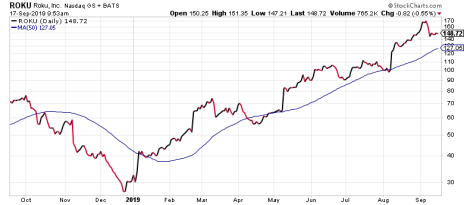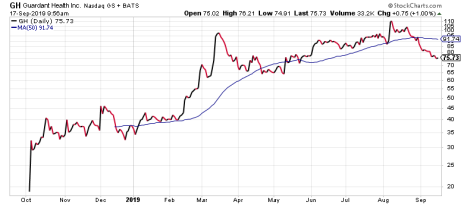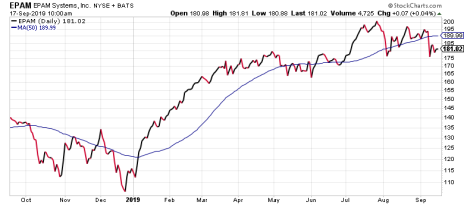The Best Mid-Cap Stocks Share Simple Traits. Here are Three that Stand Out.
One of the key tenets of our investing strategy in Cabot Small-Cap Confidential is to buy small-cap stocks with sustainable business models. The reason is simple: We’re buying stock in companies relatively early in their life cycle and if they’re going to deliver big capital gains the business must grow every year for a long time. For that to happen the business model needs to create and deliver value for customers, while allowing the company to capture its fair share of that value in terms of revenue, earnings and cash flow. The same can be said of the best mid-cap stocks, which I’ll get into in a minute.
There are other factors that matter to a company’s long-term success, of course. Management, market demand, economic conditions, etc., all play a role.




But these important factors are usually encompassed in a good company’s business model, which should theoretically endure even if a founder steps aside, a recession hits, a key customer leaves or any other number of potentially disruptive events occur (and they’re bound to over the years).
With this in mind, let’s look at a few examples of mid-sized companies that have intriguing business models that could drive outperformance for the next year. Here are my three best mid-cap stocks to buy now:
The Best Mid-Cap Stocks to Buy Now
Best Mid-Cap Stock #1: Roku (ROKU)
Roku has a market cap of $17.2 billion and is a play on the streaming TV phenomenon. Its business model revolves around a delivery platform and sales of over-the-top streaming (OTT) players. This is different from other players in the market, such as Netflix (NFLX), that are pure content plays, as well as the Amazon (AMZN), Alphabet (GOOG) and Apple (AAPL) type of model that offers some combination of streaming, content and hardware as part of a much larger business.
Roku’s Platform segment generates revenue from advertising, subscription and transaction fees, sales of branded channel buttons on remote controls, and licenses from operating systems installed on TVs. Its Player segment includes sales of OTT streaming players. For the model to work Roku needs to keep pulling users in through low-margin OTT players (segment revenue up 24% in Q2 2019) and selling them high-margin advertising through the platform segment (segment revenue up 86% in Q2 2019). In Q2 2019 total revenue was up 59.5% to $250 million while EPS of -$0.08 beat by $0.13. Active accounts were up 1.4 million to 30.5 million and streaming hours rose 72% to 9.4 billion hours. If you want rapid growth in a blazing market from a company with a good business model Roku should be on your buy list.
Best Mid-Cap Stock #2: Guardant Health (GH)
Guardant Health is another company with a compelling business model, a good story and strong fundamentals. Guardant is a precision oncology company that develops genomic blood tests that detect cancer in high-risk populations and for those with previously removed tumors. Liquid biopsy tests are the future of diagnostics in this market. And Guardant’s liquid biopsy tests are used in both biopharma (GuardantOMNI covers over 500 genes) and clinical (Guardant360 covers over 70 genes) use cases.
The company is going after a market worth over $10 billion now. But as adoption of liquid biopsy tests grows that could easily expand to $30 billion. The company reported Q2 2019 results on August 6 and basically everything was good. Revenue grew by 179% (to $54 million) and beat by $18 million while GAAP EPS of -$0.13 beat by $0.22. Tests to clinical customers grew by 77% to 11,875 while test to biopharmaceutical customers grew by 112% to 5,285.
Management says it’s still on track to make a few cancer panels eligible for Medicare coverage in 2020. It is also advancing plans to launch a prospective colorectal cancer screening study, which represents another big market opportunity. It’s hard not to love the top-line growth (estimated 2019 revenue growth is 111%), even though Guardant won’t be profitable for several years (EPS in 2020 should be -$1.32). Guardant has a market cap of just over $7 billion and the chart is beautiful despite some recent turbulence.
Best Mid-Cap Stock #3: EPAM Systems (EPAM)
EPAM Systems has a market cap of $9.3 billion and provides outsourced IT and lifecycle software development services, mostly to clients in North America and Europe. Projects include design, prototyping, testing and migration to software vendors and technology companies. It’s not the most exciting story to tell, but EPAM is a high-quality IT stock with diversified revenue streams from all sectors. This gives it a solid business model that adapts with the times. In fact, the big picture trend powering the stock higher is that EPAM helps companies engage with their clients and react to a changing competitive environment. And there’s a lot of change these days.
Roughly 20% of revenue comes from product engineering for a core group of 70 software and IT firms, while another 15% comes from major IT players like Amazon and Google, which rely on the company for complex projects. The quality of the company shows up in revenue per employee, which currently sits at around $75,000 per year, versus the industry average of $60,000.
EPAM reported Q2 2019 results on August 8 and they were above expectations. Revenue was up 23.8% to $552 million while adjusted EPS of $1.28 beat by $0.05. The average client lifespan for the company’s best clients is now at 12 years! With a stable client base and a large and productive talent pool, the company, and the stock, should continue to thrive.
An Unknown Small-Cap Stock
I recently added a stock to Cabot Small Cap Confidential that has a business model I hadn’t come across before, but which is extremely compelling.
I can’t say which industry it’s in, but the business model offers three differentiating elements that should help this small business deliver its services on a national scale.
The three keys to the platform are (1) separation of sales and service functions, (2), extensive use of cloud-based technology, and (3) a hybrid sales model deployed through both a corporate and franchise model.
The most interesting thing about this company is that while its industry is growing at 3% to 5% a year, it is growing north of 50% a year.
To learn more about this company and get my full report, you’ll need a subscription to Cabot Small-Cap Confidential. You can get that right here.

Learn More

Learn More

Learn More

Learn More
*This post has been updated from an original version.




